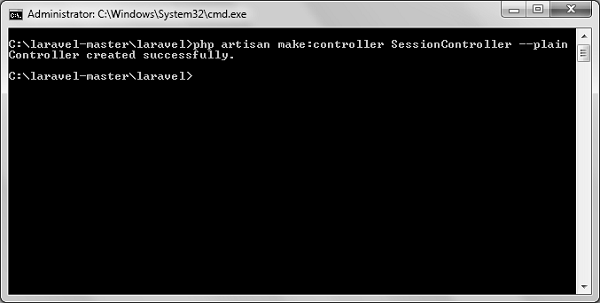
- Laravel - Home
- Laravel - Overview
- Laravel - Installation
- Laravel - Application Structure
- Laravel - Configuration
- Laravel - Routing
- Laravel - Middleware
- Laravel - Namespaces
- Laravel - Controllers
- Laravel - Request
- Laravel - Cookie
- Laravel - Response
- Laravel - Views
- Laravel - Blade Templates
- Laravel - Redirections
- Laravel - Working With Database
- Laravel - Errors & Logging
- Laravel - Forms
- Laravel - Localization
- Laravel - Session
- Laravel - Validation
- Laravel - File Uploading
- Laravel - Sending Email
- Laravel - Ajax
- Laravel - Error Handling
- Laravel - Event Handling
- Laravel - Facades
- Laravel - Contracts
- Laravel - CSRF Protection
- Laravel - Authentication
- Laravel - Authorization
- Laravel - Artisan Console
- Laravel - Encryption
- Laravel - Hashing
- Understanding Release Process
- Laravel - Guest User Gates
- Laravel - Artisan Commands
- Laravel - Pagination Customizations
- Laravel - Dump Server
- Laravel - Action URL
Laravel - Session
Sessions are used to store information about the user across the requests. Laravel provides various drivers like file, cookie, apc, array, Memcached, Redis, and database to handle session data. By default, file driver is used because it is lightweight. Session can be configured in the file stored at config/session.php.
Accessing Session Data
To access the session data, we need an instance of session which can be accessed via HTTP request. After getting the instance, we can use the get() method, which will take one argument, key, to get the session data.
$value = $request->session()->get('key');
You can use all() method to get all session data instead of get() method.
Storing Session Data
Data can be stored in session using the put() method. The put() method will take two arguments, the key and the value.
$request->session()->put('key', 'value');
Deleting Session Data
The forget() method is used to delete an item from the session. This method will take key as the argument.
$request->session()->forget('key');
Use flush() method instead of forget() method to delete all session data. Use the pull() method to retrieve data from session and delete it afterwards. The pull() method will also take key as the argument. The difference between the forget() and the pull() method is that forget() method will not return the value of the session and pull() method will return it and delete that value from session.
Example
Step 1 − Create a controller called SessionController by executing the following command.
php artisan make:controller SessionController --plain
Step 2 − After successful execution, you will receive the following output −

Step 3 − Copy the following code in a file at
app/Http/Controllers/SessionController.php.
app/Http/Controllers/SessionController.php
<?php
namespace App\Http\Controllers;
use Illuminate\Http\Request;
use App\Http\Requests;
use App\Http\Controllers\Controller;
class SessionController extends Controller {
public function accessSessionData(Request $request) {
if($request->session()->has('my_name'))
echo $request->session()->get('my_name');
else
echo 'No data in the session';
}
public function storeSessionData(Request $request) {
$request->session()->put('my_name','Virat Gandhi');
echo "Data has been added to session";
}
public function deleteSessionData(Request $request) {
$request->session()->forget('my_name');
echo "Data has been removed from session.";
}
}
Step 4 − Add the following lines at app/Http/routes.php file.
app/Http/routes.php
Route::get('session/get','SessionController@accessSessionData');
Route::get('session/set','SessionController@storeSessionData');
Route::get('session/remove','SessionController@deleteSessionData');
Step 5 − Visit the following URL to set data in session.
http://localhost:8000/session/set
Step 6 − The output will appear as shown in the following image.

Step 7 − Visit the following URL to get data from session.
http://localhost:8000/session/get
Step 8 − The output will appear as shown in the following image.

Step 9 − Visit the following URL to remove session data.
http://localhost:8000/session/remove
Step 10 − You will see a message as shown in the following image.
